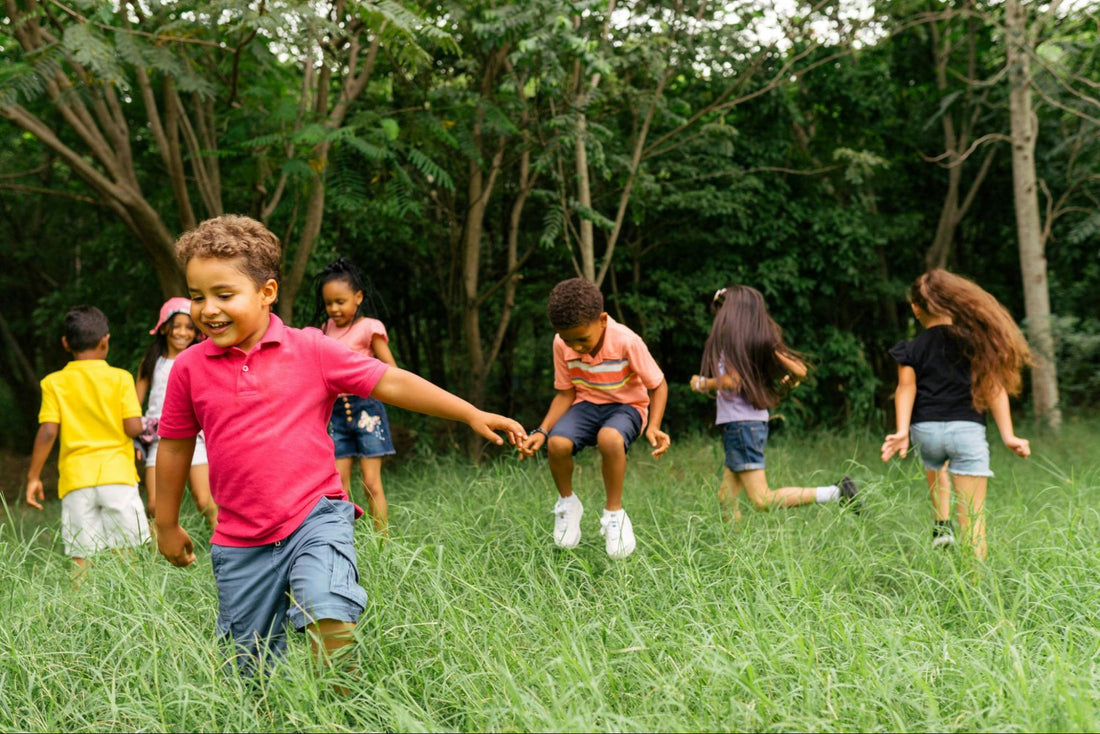An agility workout for kids can be a playful yet effective method to boost their physical fitness.
These workouts not only improve their speed and coordination but also help build strength.
Below we’ve listed all the wonderful benefits of agility workouts and getting your kids out, and active!
Benefits of Agility Workouts for Kids
Agility workouts offer kids a fun way to enhance their coordination, boost physical fitness, and sharpen mental skills. Engaging in such exercises can lead to better body control and improve overall health.
Enhanced Coordination and Balance
Agility workouts can greatly improve coordination and balance in children. By practicing exercises like hopping, skipping, and running through obstacle courses, kids learn to synchronize their movements. These activities require them to adapt quickly to changing environments, which helps fine-tune their motor skills.
Developing coordination is essential for kids, as it aids in everyday tasks and sports. With improved balance, children can move confidently in various physical activities. This increase in body control reduces the risk of injury and supports their growth.
Improved Physical Fitness
Regular agility workouts contribute significantly to a child's physical fitness. Engaging in dynamic activities that involve quick movements boosts cardiovascular health and strengthens muscles. These exercises are a fun way for kids to stay active and avoid sedentary habits.
Participating in agility drills encourages children to push their physical limits. It helps build endurance, speed, and strength, making them fitter and healthier. As kids progress, their increased physical fitness can lead to better performance in school and recreational activities.
Boosted Mental Sharpness
Agility workouts don't just benefit the body; they enhance mental sharpness as well. When kids engage in exercises requiring quick decision-making and adaptation, they improve cognitive functions like concentration and reaction time.
Such activities stimulate the mind and teach kids problem-solving skills. They learn to anticipate their next move, which aids in developing strategic thinking. Encouraging mental sharpness through agility exercises can help children excel academically and socially.
Bijou Build offers an ideal play system that complements these benefits. With a modular design and durable materials, you can create a play area that blends with your yard's aesthetics. The Play System is versatile, allowing you and your child to climb, swing, and relax. Its stability and ease of setup make it a great choice for enhancing your child's agility workouts.
Fundamentals of Designing an Agility Workout
Designing an agility workout for kids should be fun, age-appropriate, and safe. You want exercises that engage children and keep them motivated while also enhancing their agility.
Age-Appropriate Exercises
When designing workouts, it's important to consider the age of the children. For younger kids, focus on playful activities that improve balance, coordination, and basic agility. Simple games like relay races or obstacle courses are effective. For older kids, you can introduce more complex movements that challenge their agility and speed, such as ladder drills or cone weaving.
Tailoring exercises to suit the age group not only boosts agility but also ensures that the kids remain engaged and interested in the activities. Activities should be manageable yet challenging enough to promote growth.
Incorporating Fun and Variety
To maintain interest, mix up the activities. Kids are more likely to stay engaged in a workout that is varied. You can include games like freeze tag and shadow tag as part of the routine. These games not only enhance agility but also encourage teamwork and social interaction.
By mixing the types of activities and incorporating elements of play, you help create a positive attitude towards exercise. Fun workouts keep kids coming back, which is key for developing long-term healthy habits.
Safety Considerations
Safety should always be a top priority when designing an agility workout. Ensure that the environment is safe for kids to move around freely. Secure any obstacle course elements and provide guidance on how to perform exercises properly to minimize the risk of injury.
Warm-Up Routines
Warm-up routines are important for kids to prevent injuries and improve performance during agility workouts. They involve activities that gradually prepare the body, such as dynamic stretching and light cardiovascular exercises. These activities help increase heart rate and flexibility.
Dynamic Stretching
Dynamic stretching involves moving parts of your body through a full range of motion. This helps loosen muscles and improves flexibility. For kids, these stretches can include arm circles, leg swings, and torso twists.
This type of stretching is effective because it mimics movements kids will perform during their workout. It boosts blood flow to muscles, preparing them for more intense activities. It's crucial to perform these stretches in a controlled manner to prevent injury.
Dynamic stretches are especially beneficial before agility exercises like hopping, skipping, or running. Encourage kids to perform each stretch for about 30 seconds, ensuring they focus on form and not speed. Consistent practice of dynamic stretching helps improve overall agility and coordination.
Light Cardiovascular Activities
Light cardiovascular activities are great for getting the heart rate up and preparing the body for more vigorous exercise. Activities like jogging in place, jumping jacks, and skipping are effective warm-ups for kids. These exercises help increase blood circulation and raise body temperature, which reduces the risk of injury.
Begin with a slow pace to emphasize warming up gradually. Kids often enjoy activities that feel like play, so consider incorporating fun challenges or variations, such as high knees or arm movements, to keep them engaged.
Cardiovascular activities help children focus and energize them for the upcoming agility drills. By regularly including these exercises in warm-up routines, you help improve cardiovascular fitness and enhance readiness for more challenging actions.
Core Agility Drills
Core agility drills are a fantastic way to enhance your child's speed and coordination. They are designed to help kids develop quick reflexes and improve balance through engaging activities. Here are some effective drills to incorporate into a workout routine for kids.
Obstacle Courses
Obstacle courses are an exciting way to build agility in children. Set up a course using everyday items like chairs, ropes, and toy boxes. Encourage kids to crawl under, jump over, and run around these obstacles. This activity improves coordination and encourages creative movement.
Ladder Drills
Ladder drills are excellent for developing foot speed and agility. Create a ladder on the ground using tape if you don't have a physical one. Kids can practice quick foot movements by stepping in and out of the ladder's spaces. This helps with balance and coordination. Start with simple patterns, like one foot per square, then add more complex sequences.
Cone Drills
Cone drills are versatile and can be customized to focus on different agility skills. Arrange cones in various patterns, such as zig-zags or squares. Have kids weave through the cones, practice quick turns, and change direction swiftly. These drills enhance reflexes and spatial awareness.
Sport-Specific Agility Training
In sport-specific agility training, you can tailor workouts to enhance skills unique to different sports. This includes developing quick foot movements for soccer, fine-tuning precise footwork for basketball, and improving start-and-stop techniques crucial for track and field events.
Soccer Agility Drills
Soccer players need exceptional agility for quick changes in direction and speed on the field. Incorporating cone drills into your routine can be beneficial. Set up cones in a zig-zag pattern and practice quick sprints from cone to cone, focusing on sharp direction changes. Ladder drills can also enhance footspeed and coordination.
Improving reaction time is vital. Try exercises where you respond to visual cues for sprinting and maneuvering.
Basketball Footwork Exercises
In basketball, agility is more about explosive movements and developing the ability to change direction quickly. Drills that emphasize these movements are essential. Consider shuttle runs that improve your speed and foot control. Incorporate short sprints combined with defensive slides to simulate game conditions.
Using a jump rope can boost your quickness and balance.
Track and Field Agility Practices
Track and field athletes benefit from drills that enhance both speed and precision. Using hurdles, practice quick, clean jumps to improve your agility and coordination. Speed ladder drills are also excellent for enhancing footspeed and managing rapid directional shifts.
Focusing on reaction drills like sprint starts can help improve performance.
Cool-Down Activities
Cool-down activities are crucial after an agility workout for kids. These routines help the body transition from exercise to rest, minimizing muscle stiffness and promoting flexibility. Additionally, children learn to reflect on their workout experience, understanding what went well and how they can improve next time.
Stretching for Flexibility
Stretching helps relax the muscles and increase flexibility. It is important to focus on both upper and lower body stretches. Simple stretches such as arm circles or toe touches are easy for kids to perform. Encourage them to hold each stretch for about 15-30 seconds.
By integrating stretching exercises, kids are less likely to feel sore the next day. This makes it easier for them to stay active.
Reflecting on the Workout
Encouraging kids to reflect on their workout helps them build a positive mindset towards exercise. Ask them simple questions about what activities they enjoyed and what they found challenging. This helps them recognize their progress and areas for improvement.
Creating a short routine where they jot down or discuss their thoughts can be effective. This helps them connect emotionally to their physical activities.
Monitoring Progress and Adapting the Workout
To monitor your child's agility progress, use simple observational techniques. Watch them perform movements like jumping or running. Take note of their coordination and speed. Keep track in a checklist to see improvements over time. You can also use short, fun assessments to gauge their agility.
Adapting the workout is key to keeping children engaged. As they improve, introduce new challenges. Change the course layout or add new obstacles. This keeps the workout fun and exciting while promoting continued growth.
Feedback is important. Encourage your child by pointing out what they do well. Offer specific tips on how to improve. This approach helps them feel motivated and supported.
Tips for Keeping Children Motivated
Keeping kids motivated during agility workouts can be a fun and rewarding experience. Make the activities enjoyable and engaging to ensure they look forward to each session.
-
Set Goals:
Establish clear and achievable goals. Kids feel motivated when they know what they are working towards. Celebrate small victories to keep their spirits high. -
Create a Fun Environment:
Use creative setups and equipment. With the our Play System, you can easily build a space that both challenges and excites. Its modular design offers room for creativity, letting you customize structures for climbing and swinging. -
Offer Variety:
Introduce new games and exercises regularly to maintain interest. Variations like freeze tag and shadow tag provide mental and physical challenges, preventing boredom. -
Encourage Play:
Outdoor play lets kids explore and have fun, which naturally boosts their motivation. -
Involve Them in Setup:
Let kids participate in building their play area this helps make it a personal project that gives them a sense of ownership and excitement. -
Make It Aesthetic:
Children feel more motivated in a pleasing environment. -
Balance Challenge and Ease:
Ensure activities are neither too hard nor too easy. Adjust the height or complexity of climbing and swinging areas as needed to keep everyone engaged without frustration.
Parental Involvement and Support
Your support plays a vital role in your child's agility workout. Engaging with your child during activities not only strengthens your bond but also boosts their confidence. Encourage them as they take on new challenges, and celebrate their achievements, no matter how small.
Creating a Safe Environment
Ensure the play area is safe. Check that surfaces are suitable for exercise, free of hazards, and that equipment is secure.
Engage in Active Participation
Join your child in their activities to make workouts more enjoyable. Whether climbing, swinging, or playing in the shade, your involvement makes a big difference.
Motivation and Encouragement
Cheer them on and provide positive feedback. Your enthusiasm can motivate them to push their limits.

